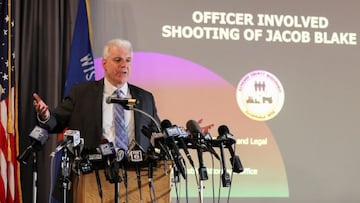Why were no charges brought against the police officer who shot Jacob Blake?
Blake was shot in the back in August 2020 by officers responding to a suspected domestic incident and was left paralyzed from the waist down.

While the United States grapples with yet another police killing of a young black man, Daunte Wright, in Minnesota, questions remain about the shooting of Jacob Blake, which occurred in August 2020.
The officers involved in the shooting of Jacob Blake, 29, responded to a call about a domestic incident. Once police arrived on the scene, a confrontation ensued, and Officer Rusten Sheskey, claiming self-defense, shot Mr. Blake in the back seven times as he tried to flee. The injuries sustained by Mr. Blake left him paralyzed from the waist down. After the shooting, Officer Sheskey was placed on administrative leave, a common practice after an event of this nature, until an investigation could be completed.
The investigation was finalized in early January 2021, and although it was determined that no charges would be brought forward against Officer Sheskey, he remained on administrative leave.
What did the District Attorney’s report say on bringing charges forward?
In District Attorney Graveley’s report on the investigation, he stated that “the events of August 23, 2020 were a tragedy— for Jacob Blake, for the people who love him, for his children who were witnesses, for the City of Kenosha”, but that after considering the evidence of the case available to him, he “did not believe the State could prove beyond a reasonable doubt that Officer Sheskey was not acting lawfully in self-defense or defense of others which 4 is the legal standard the State would have to meet to obtain a criminal conviction in this case.”
After the District Attorney’s report was released, one of the lawyers representing Mr. Blake, Benjamin Crump, articulated his disappointment with the decision stating that the findings send “the wrong message to police officers throughout the country. It says it is OK for police to abuse their power and recklessly shoot their weapon, destroying the life of someone who was trying to protect his children."
In March, Mr. Blake brought an action against Officer Sheskey in civil court for using excessive force. The damages requested have not been specified.
- Who is the suspect in killing of US Capitol Police officer?
- Derek Chauvin and Tou Thao: who are the two cops in the George Floyd case?
- Derek Chauvin on trial for George Floyd death: what charges were presented?
- Death of George Floyd: How much will Minneapolis pay to settle the lawsuit
What was the response for the Kenosha Police Department?
Related stories
On April 13th, Kenosha Police Department released a statement to the media alerting the public that Officer Sheskey had been reinstated as of March 31st and that the department understood that “some would not be pleased with the outcome” but that “given the facts, the only lawful and appropriate decision was made.” This decision to reinstate Officer Sheskey was made based on the investigations finding and the conclusion that he acted in accordance with department police.
Media Release pic.twitter.com/wdq5QaNNyk
— Kenosha Police Dept. (@KenoshaPolice) April 13, 2021
Jacob Blake’s case and its place within the broader discussion on excessive force by police
The shooting of Jacob Blake is complicated. The case forces those in the United States to reckon with how police officers use deadly force and the frequency in which Black Americans, specifically Black men are the targets of this force. The arguments made by the District Attorney and the Kenosha Police Department illustrate the difficult situations police in the United States find themselves in, particularly given the widespread availability of firearms in the country, meaning police are constantly wary that they could come under fire. But as many racial justice advocates, like the American Civil Liberties Union, remind the public when cases like that of Mr. Blake arise, targeting the systemic issues of poverty and racism in this country could protect police officers and the communities they serve.